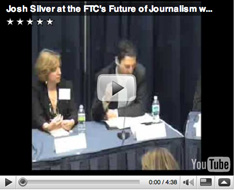
Leading Role for Public Media at 'Future of Journalism' Workshop
 The second act of the Federal Trade Commission (FTC’s) production of the latest off-Broadway hit, “Much Ado about the Future of Journalism,” came with a nice plot twist. Rep. Henry Waxman (D-Calif.) kicked it off yesterday
with a commendable soliloquy that pushed the market forces argument out
of the spotlight by introducing suggestions for policy changes to
promote a “vigorous” free press.
The second act of the Federal Trade Commission (FTC’s) production of the latest off-Broadway hit, “Much Ado about the Future of Journalism,” came with a nice plot twist. Rep. Henry Waxman (D-Calif.) kicked it off yesterday
with a commendable soliloquy that pushed the market forces argument out
of the spotlight by introducing suggestions for policy changes to
promote a “vigorous” free press.
Others have raised red flags about the dangers of government support of the press. I have an open mind on all the above proposals. In the face of continuing closures of mastheads across the country, I see every reason to discuss them.
It was a laudable setup for the morning’s first panel on “Public and Foundation Funded Journalism,” a high-profile lineup of speakers from the public media, academic, journalism and advocacy worlds who challenged the notion that government should stay far away from this issue.
The panelists spent some time myth-busting Tuesday’s (Act One’s) theme that government has no role to play in supporting the future of journalism. And they seemed to agree on at least one important point: We need to fund newsgathering and journalism, while finding ways to keep the government from interfering in news content.
A Return on Investment
Given the subject matter, the inclusion of the public broadcasting community (representatives from National Public Radio, American Public Media and the Corporation for Public Broadcasting were featured) in the cast was unsurprising. After all, we have been investing in public broadcasting for more than 40 years, and the system has continued to grow, despite the fact that, as Joaquín Alvarado of the CPB mentioned, it is one of the lowest-funded public media systems in the industrialized world.
Vivian Schiller, president and CEO of NPR, was quick to cite the advantages of building on public media’s existing infrastructure and networks, and highlighted the impact that increased government investment would bring:
… An increased investment into public media, the [return on investment] on that … in support of this public service … will go further than I can imagine of any so-called bailout of the commercial newspaper industry… The system is there, it works, it needs support so we can develop the kind of infrastructures and systems to be able to deliver on the digital age.
Delivering quality journalism in the digital age was a key concern for many of the other panelists, who prioritized innovation over propping up legacy models. But what has to be maintained, they said, is the public service mission at public media’s core. And most echoed a need for public service journalism at the local level.
After their opening remarks, the panelists launched into a discussion, emphasizing the essential need for increased public funding for journalism.
 “There is not enough private money in the forms of advertising
revenue, subscription revenue, philanthropy and otherwise to support
particularly the local journalism that our informed, participatory
democracy requires,” said Josh Silver, executive director of Free Press.
“There is not enough private money in the forms of advertising
revenue, subscription revenue, philanthropy and otherwise to support
particularly the local journalism that our informed, participatory
democracy requires,” said Josh Silver, executive director of Free Press.
But the future of journalism is about more than just the business model. It's about a radical shift in how we think about the distribution of information. And that shift requires that we view information the same way we view things like public safety and education: They are too important to be left solely to free market forces.
Strengthening Firewalls
To put it in perspective, Silver summoned some shocking statistics. The U.S. government spent 175 times as much money on AIG than they did on the CPB last year. And it spent three times as much on office furniture in Congress as it did on public media. So while the public’s information needs continue to grow, especially as commercial media falter, our public media system is woefully underfunded.
Despite the great need for investment, it is also evident that we need to proceed thoughtfully. Protecting the firewall between the government and journalism was a crucial point of agreement among panelists. Schiller argued that journalism has always been subsidized (by advertisers, foundations or the government), but that any news organization “worth its salt” would have a strong internal firewall to allow journalists to do their jobs without interference or undue influence.
Meanwhile, Silver said that the easiest way to ensure a firewall was to remove the funding process for public media from the congressional appropriations cycle and to do away with presidential appointments to the CPB board. “It’s too political,” Silver stated, “and there are other ways to do it.”
It’s true that a dramatic reinvestment in our national public media system requires strong barriers between the newsroom and sources of funding . But it also necessitates greater diversity – of audiences, content and platforms – and a broader definition of what public media are. It requires a shift, Silver said, from an attitude of scarcity to an attitude of abundance.
Intermission’s clearly over. We can’t waste time; let’s get on with act three.


